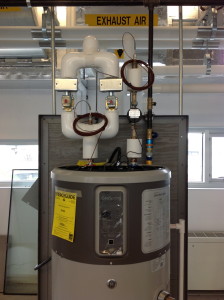 Water heating is the second largest energy use in New York homes. Historically, efforts to improve residential efficiency have focused on space conditioning, often neglecting water heating improvements. Several new or recently-refined technologies are now available on the market including, solar water heaters, gas-fired tank-less units, and heat pump water heaters. Tax credits are currently available for these systems which are expected to accelerate consumer interest. Current DOE rating procedures to determine the Energy Factor (EF), or efficiency, of these diverse systems may not reflect actual performance. The magnitude and timing of water use greatly impacts the performance and relative ranking of these systems. Robust measured data are needed to help consumers, manufacturers, and installers understand the efficiency, costs, and environmental impacts of both new and conventional domestic hot water systems.
Water heating is the second largest energy use in New York homes. Historically, efforts to improve residential efficiency have focused on space conditioning, often neglecting water heating improvements. Several new or recently-refined technologies are now available on the market including, solar water heaters, gas-fired tank-less units, and heat pump water heaters. Tax credits are currently available for these systems which are expected to accelerate consumer interest. Current DOE rating procedures to determine the Energy Factor (EF), or efficiency, of these diverse systems may not reflect actual performance. The magnitude and timing of water use greatly impacts the performance and relative ranking of these systems. Robust measured data are needed to help consumers, manufacturers, and installers understand the efficiency, costs, and environmental impacts of both new and conventional domestic hot water systems.
Learn more about Domestic Hot Water.
Lab Data
We have systems installed and collected data for the Laboratory at the COE.
Test Overview and Objectives
The laboratory test setup is designed to provide head-to-head comparisons of different water heating (WH) systems under the same load conditions (i.e., hot water use patterns). The laboratory includes different test stations for nine different water heaters. The side-by-side setup allows weather dependent systems – such as solar water heating systems and heat pump water heaters – to be directly compared to other systems on a daily basis under different load and weather conditions. This test setup is similar to a laboratory at Florida Solar Energy Center in Cocoa, Florida . The FSEC laboratory is directly comparing WH system performance for Southern Climates. Our goal is to provide a similar side-by-side assessment of actual WH system performance under conditions that are representative of Northeastern residential applications.
Testing for Cold Climate
The primary operating mode for laboratory will be to allow entering cold water temperatures to float with seasonal conditions – in order to simulate actual conditions for a home in Syracuse. The plot in Figure 1 shows the typical annual profile of cold water temperatures from a Syracuse home; conditions at laboratory facility are expected to be similar. However, in order to complete a standardized test according to the DOE test procedure, we will also add a mixing valve and buffering tank at the cold water inlet to the test setup. This will allow for some heated water from the tank to be blended in with the cold water stream to achieve the 58°F required by the DOE test procedure. This approach of blending in hot water is expected to allow us to run a standardized test for about half the year (i.e., in the winter when the city water temperature is below 58°F).
Laboratory Setup
The laboratory is in two locations at SyracuseCoE. Two (2) gas-fired units are located in stations 1 and 2 on the first floor. The 1st floor location allows for a conventional natural-draft, gas-fired water heater, by using the existing flue in the space. The other seven (7) systems are located on the fourth floor. Three of the test stations allow for power-vented gas-fired units (stations 6, 7 and 8) and four other stations (stations 3, 4, 5, and 9) can support electric units, which will include the conventional electric tank, two solar systems, and a heat pump water heater. The solar collectors will be located on the roof of the building, which is above the 5th floor (see Figure 3). Each test station is built around a metal and plywood frame for mounting the necessary utilities (cold water, hot water, gas, and electric) and as well as control wiring and instrumentation.
